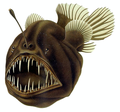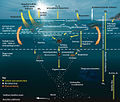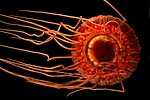The mesopelagic zone (Greek μέσον, middle), also known as the middle pelagic or twilight zone, is the part of the pelagic zone that lies between the photic...
50 KB (6,027 words) - 07:06, 7 June 2024
Pelagic fish (redirect from Mesopelagic fish)
other mesopelagic fish when it bites them with its dagger-like teeth. Bigeye tuna cruise the epipelagic zone at night and the mesopelagic zone during...
74 KB (8,432 words) - 20:02, 3 August 2024
zone refers to the greatest depths, deeper than the abyssal zone. Some twilight occurs in the mesopelagic zone, but creatures below the mesopelagic must...
10 KB (1,128 words) - 12:51, 15 August 2023
most abundant organisms thriving into the mesopelagic zone are heterotrophic bacteria. Animals living in this zone include swordfish, squid, wolffish and...
14 KB (1,451 words) - 18:48, 9 July 2024
Deep-sea fish (section Mesopelagic fish)
mesopelagic (200–1,000 metres (656–3,281 ft) deep) zone as well. The mesopelagic zone is the disphotic zone, meaning light there is minimal but still measurable...
59 KB (6,785 words) - 09:10, 15 June 2024
surface. It lies between the mesopelagic above and the abyssopelagic below. The bathypelagic is also known as the midnight zone because of the lack of sunlight;...
49 KB (5,362 words) - 13:11, 13 May 2024
Water column (section Mesopelagic)
mesopelagic zone receives very little sunlight and is home to many bioluminescent organisms. Because food is scarce in this region, most mesopelagic organisms...
8 KB (832 words) - 09:26, 25 August 2024
Deep-sea community (section Mesopelagic)
dysphotic zone (dysphotic means "poorly lit" in Greek). The dysphotic zone is also referred to as the mesopelagic zone, or the twilight zone. Its lowermost...
37 KB (4,719 words) - 13:56, 11 August 2024
side of a planetary body Mesopelagic zone, or twilight zone, at a depth of 200–1000m below the ocean surface Twilight Zone, a nightclub in Toronto Entertainment...
3 KB (350 words) - 23:34, 2 January 2022
captured footage of an oarfish swimming in its natural habitat in the mesopelagic zone in the Gulf of Mexico. It is the first ever confirmed sighting of an...
27 KB (3,207 words) - 10:30, 19 August 2024
to the epipelagic zone. From 200 to 1000 metres lies the dysphotic zone, or the twilight zone (corresponding with the mesopelagic zone). There is still...
25 KB (2,955 words) - 08:17, 23 May 2024
oceanic zone. The open ocean is vertically divided into four zones: the sunlight zone, twilight zone, midnight zone, and abyssal zone. The Mesopelagic (disphotic)...
5 KB (588 words) - 09:19, 25 June 2024
Praya dubia, the giant siphonophore, lives in the mesopelagic zone to bathypelagic zone at 700 m (2,300 ft) to 1,000 m (3,300 ft) below sea level. It...
8 KB (768 words) - 18:59, 28 March 2024
fish in the genus Chauliodus. Viperfishes are mostly found in the mesopelagic zone and are characterized by long, needle-like teeth and hinged lower jaws...
18 KB (1,996 words) - 22:59, 20 February 2024
Abyssal plain (section Oceanic zones)
dysphotic zone (dysphotic means "poorly lit" in Greek). The dysphotic zone is also referred to as the mesopelagic zone, or the twilight zone. Its lowermost...
80 KB (9,035 words) - 11:43, 27 July 2024
Bioluminescence (section Pelagic zone)
the mesopelagic zone, but the benthic zone at mesopelagic depths has remained widely unknown. Benthic habitats at depths beyond the mesopelagic are also...
75 KB (8,096 words) - 09:16, 17 August 2024
inches, though some can be larger. They are most commonly found in the mesopelagic zone of the ocean, mostly at depths of over 300 meters (1,000 feet), and...
14 KB (1,534 words) - 21:51, 24 October 2023
of the family Pseudocarchariidae. A specialized inhabitant of the mesopelagic zone, the crocodile shark can be found worldwide in tropical waters from...
19 KB (2,206 words) - 04:57, 31 March 2024
are found worldwide, outside of the Arctic and Subantarctic, in the mesopelagic zone below a depth of 500 meters (1,600 feet). This genus once contained...
11 KB (1,348 words) - 14:29, 19 July 2024
clouds obscure the moon. Most mesopelagic fish make daily vertical migrations, moving at night into the epipelagic zone, often following similar migrations...
28 KB (3,417 words) - 03:42, 17 June 2024
islands. Most mesopelagic fishes are small filter feeders which ascend at night to feed in the nutrient rich waters of the epipelagic zone. During the day...
8 KB (856 words) - 15:58, 10 August 2024
this mesopelagic zone. This diving pattern may follow a diel vertical migration but without more evidence on the biomass of their prey within this zone, these...
20 KB (2,560 words) - 06:41, 26 February 2024
production is exported out of the euphotic zone, which attenuates exponentially towards the base of the mesopelagic zone and only about 1% of the surface production...
22 KB (2,737 words) - 21:03, 24 June 2024
out of the mesopelagic zone (at approximately 1000 m depth) as the "sequestration flux". Once carbon is transported below the mesopelagic zone, it remains...
145 KB (16,337 words) - 10:20, 2 June 2024
appear like a strawberry with seeds. H. heteropsis live in the ocean's mesopelagic zone and are found in the California Current and the Humboldt Current. Little...
13 KB (1,569 words) - 15:55, 26 August 2024
the crocodile shark family. It is a specialized inhabitant of the mesopelagic zone, found worldwide in tropical waters from the surface to a depth of...
35 KB (1,795 words) - 04:54, 4 July 2024
Atollidae by Henry Bigelow in 1913. The six known species inhabit the mesopelagic zone. The medusae possess multiple lobes called lappets at the bell margin...
3 KB (236 words) - 06:19, 22 April 2024
evermannellids. They are active, visual predators and confine themselves to the mesopelagic zone, about 400m - 1000m for adults. However, larvae and small juvenile...
10 KB (1,202 words) - 06:26, 14 February 2024
The hadal zone, also known as the hadopelagic zone, is the deepest region of the ocean, lying within oceanic trenches. The hadal zone ranges from around...
26 KB (2,533 words) - 21:36, 7 August 2024
from the Greek μυκτήρ myktḗr, "nose" and ophis, "serpent") are small mesopelagic fish of the large family Myctophidae. One of two families in the order...
17 KB (1,831 words) - 02:50, 22 August 2024






















